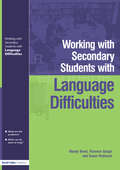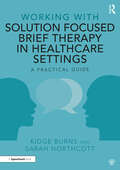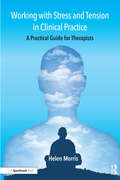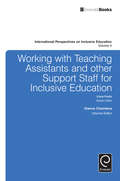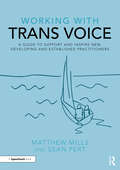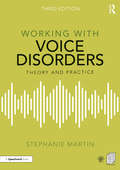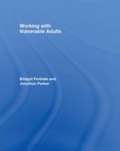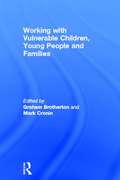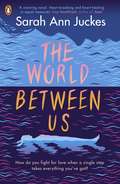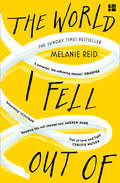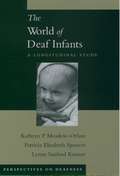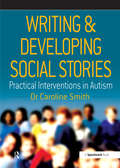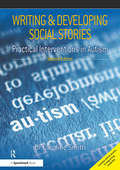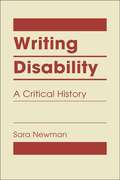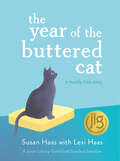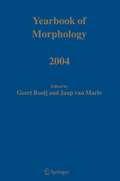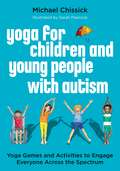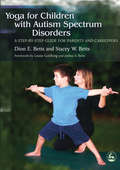- Table View
- List View
Working with Secondary Students who have Language Difficulties
by Mary Brent Florence Gough Susan RobinsonLanguage is the foundation of everything that goes on at school and is critical for formal learning and to interact socially. This book represents a whole school approach that includes tips for: identifying pupils with language learning difficulties following the book's simply explained guidelines; helping pupils overcome stumbling blocks by using the book's practical classroom strategies; modifying the schools curriculum to best support pupils with language learning difficulties; and timesaving resources in photocopiable format.
Working with Secondary Students who have Language Difficulties
by Mary Brent Florence Gough Susan RobinsonLanguage is the foundation of everything that goes on at school and is critical for formal learning and to interact socially. This book represents a whole school approach that includes tips for: identifying pupils with language learning difficulties following the book's simply explained guidelines; helping pupils overcome stumbling blocks by using the book's practical classroom strategies; modifying the schools curriculum to best support pupils with language learning difficulties; and timesaving resources in photocopiable format.
Working with Solution Focused Brief Therapy in Healthcare Settings: A Practical Guide (Working With)
by Kidge Burns Sarah NorthcottSolution focused brief therapy is an evidence-based approach that enables people to make meaningful change in their everyday lives. This book shares ideas on how speech and language therapists and others working in medical settings can integrate SFBT into their therapeutic interactions to support clients handling acute or chronic health conditions. It outlines core aspects of the approach in an accessible format, bridging the gap between theory and practice, and provides guidance on adapting SFBT for clients living with communication disabilities. There are suggestions for different clinical situations, with real-life case examples drawn from working with people living with Parkinson’s disease, stroke, motor neurone disease, cancer and chronic pain. Combining practical advice with photocopiable resources, this book covers: • Establishing person-centred, holistic goals for therapy • Future focused descriptions • Building on a person’s resources and successes • Responding to distress • Supervision and support This accessible book can be read as an introductory text for those new to this approach and will also be invaluable to clinicians who have already received some training in SFBT. It is likely to become a trusted resource, supporting allied health professionals and others to ensure their therapy is grounded in client priorities.
Working with Solution Focused Brief Therapy in Healthcare Settings: A Practical Guide (Working With)
by Kidge Burns Sarah NorthcottSolution focused brief therapy is an evidence-based approach that enables people to make meaningful change in their everyday lives. This book shares ideas on how speech and language therapists and others working in medical settings can integrate SFBT into their therapeutic interactions to support clients handling acute or chronic health conditions. It outlines core aspects of the approach in an accessible format, bridging the gap between theory and practice, and provides guidance on adapting SFBT for clients living with communication disabilities. There are suggestions for different clinical situations, with real-life case examples drawn from working with people living with Parkinson’s disease, stroke, motor neurone disease, cancer and chronic pain. Combining practical advice with photocopiable resources, this book covers: • Establishing person-centred, holistic goals for therapy • Future focused descriptions • Building on a person’s resources and successes • Responding to distress • Supervision and support This accessible book can be read as an introductory text for those new to this approach and will also be invaluable to clinicians who have already received some training in SFBT. It is likely to become a trusted resource, supporting allied health professionals and others to ensure their therapy is grounded in client priorities.
Working with Stress and Tension in Clinical Practice: A Practical Guide for Therapists
by Helen MorrisWorking with Stress and Tension in Clinical Practice is a practical toolkit that sets out a wide range of approaches for reducing stress and anxiety in clients so that they are mentally prepared for more effective therapy sessions. Combining research, real-life examples and practical advice, the book discusses the potential psychological barriers to therapy that can stand in the way of helping clients and offers concrete solutions to overcome these issues. This toolkit clearly outlines a range of approaches such as mindfulness and meditation techniques that can help clients focus on their therapy and overcome stress and anxiety. Key features include: Guidance and activities supporting the use of meditation, breathing exercises and visualisation techniques in therapy Ideas that can be used as short introductory activities at the beginning of a therapy session to help patients get the most from the therapist’s time Suggested whole sessions on stress-reduction for those focusing on anxiety itself. This book is a must-have resource for Speech and Language Therapists, Occupational Therapists, Psychologists, Counsellors, Psychotherapists and any professionals working with clients who wish to help the people they work with get the most from therapy.
Working with Teachers and Other Support Staff for Inclusive Education (International Perspectives on Inclusive Education #4)
by Dianne ChambersSupport staff in schools are increasingly recognised as playing an important, though often undefined, role in inclusive education. While there has been some research on how best to work with support staff, this book provides readers with a comprehensive examination of roles and responsibilities within the classroom. Issues in determining appropriate ways to work effectively with support staff are raised, along with strategies teachers can use to enhance the collaborative and reflective nature of working with others.
Working with Trans Voice: A Guide to Support and Inspire New, Developing and Established Practitioners (Working With)
by Matthew Mills Sean PertThis book is an essential resource for those new to, developing and established in the field of trans voice. Presented in a workbook style and packed with practical exercises for the practitioner to engage with, it explores and explains how to work with clients effectively, while also developing vital cultural knowledge and fundamental skills in voice coaching that will help the practitioner develop insight into and support each person’s unique journey. Matthew Mills and Sean Pert draw on their wealth of experience to encourage the reader to consider what gender means to them, and how gender performance may be taken for granted by people whose gender identity aligns with their sex assigned at birth. The key learning points of this book are illustrated by guiding comments from trans and non-binary people with lived, practical and clinical experience Based on the latest expert practice and informed by the experiences of the clients themselves, Working with Trans Voice allows speech and language therapists and other professionals interested in supporting trans and gender-diverse people to develop the confidence to work with their clients in partnership and solidarity.
Working with Trans Voice: A Guide to Support and Inspire New, Developing and Established Practitioners (Working With)
by Matthew Mills Sean PertThis book is an essential resource for those new to, developing and established in the field of trans voice. Presented in a workbook style and packed with practical exercises for the practitioner to engage with, it explores and explains how to work with clients effectively, while also developing vital cultural knowledge and fundamental skills in voice coaching that will help the practitioner develop insight into and support each person’s unique journey. Matthew Mills and Sean Pert draw on their wealth of experience to encourage the reader to consider what gender means to them, and how gender performance may be taken for granted by people whose gender identity aligns with their sex assigned at birth. The key learning points of this book are illustrated by guiding comments from trans and non-binary people with lived, practical and clinical experience Based on the latest expert practice and informed by the experiences of the clients themselves, Working with Trans Voice allows speech and language therapists and other professionals interested in supporting trans and gender-diverse people to develop the confidence to work with their clients in partnership and solidarity.
Working with Voice Disorders: Theory and Practice (Working With)
by Stephanie MartinNow in a fully revised and updated third edition, Working with Voice Disorders offers practical insight and direction into all aspects of voice disorders, from assessment and diagnosis to intervention and case management. Using evidence-based material, it provides clinicians with pragmatic, accessible support, facilitating and informing decision-making along the clinical journey, from referral to discharge. Key features of this resource include: A wealth of new, up-to-date practical and theoretical information, covering topics such as the prevention, assessment, intervention and treatment of a wide spectrum of voice disorders. A multi-dimensional structure, allowing the clinician to consider both specific aspects of patient management and aspects such as clinical effectiveness, clinical efficiencies and service management. Photocopiable clinical resources, from an at-a-glance summary of voice disorders to treatment and assessment protocols, and practical exercises and advice sheets for patients. Sample programmes for voice information groups and teacher workshops. Checklists for patients on topics such as the environmental and acoustic challenges of the workplace. Self-assessed personalised voice review sheets and weekly voice diaries encourage patients to monitor their voice quality and utilise strategies to prevent vocal misuse. Combining the successful format of mixing theory and practice, this edition offers a patient-centred approach to voice disorders in a fully accessible and easy-to-read format and addresses the challenges of service provision in a changing world. This is an essential resource for speech and language therapists of varying levels of experience, from student to specialist.
Working with Voice Disorders: Theory and Practice (Working With)
by Stephanie MartinNow in a fully revised and updated third edition, Working with Voice Disorders offers practical insight and direction into all aspects of voice disorders, from assessment and diagnosis to intervention and case management. Using evidence-based material, it provides clinicians with pragmatic, accessible support, facilitating and informing decision-making along the clinical journey, from referral to discharge. Key features of this resource include: A wealth of new, up-to-date practical and theoretical information, covering topics such as the prevention, assessment, intervention and treatment of a wide spectrum of voice disorders. A multi-dimensional structure, allowing the clinician to consider both specific aspects of patient management and aspects such as clinical effectiveness, clinical efficiencies and service management. Photocopiable clinical resources, from an at-a-glance summary of voice disorders to treatment and assessment protocols, and practical exercises and advice sheets for patients. Sample programmes for voice information groups and teacher workshops. Checklists for patients on topics such as the environmental and acoustic challenges of the workplace. Self-assessed personalised voice review sheets and weekly voice diaries encourage patients to monitor their voice quality and utilise strategies to prevent vocal misuse. Combining the successful format of mixing theory and practice, this edition offers a patient-centred approach to voice disorders in a fully accessible and easy-to-read format and addresses the challenges of service provision in a changing world. This is an essential resource for speech and language therapists of varying levels of experience, from student to specialist.
Working With Vulnerable Adults
by Bridget Penhale Jonathan ParkerProvides an understanding of the professional practice in social and health care. This book examines abuse of vulnerable adults and the ways in which social policy, welfare services and practitioners may compound or alleviate vulnerability. It includes coverage of social work, social care settings and vulnerable adults. 9780415301916 9780203492932
Working with Vulnerable Adults (PDF)
by Bridget Penhale Jonathan ParkerProvides an understanding of the professional practice in social and health care. This book examines abuse of vulnerable adults and the ways in which social policy, welfare services and practitioners may compound or alleviate vulnerability. It includes coverage of social work, social care settings and vulnerable adults. 9780415301916 9780203492932
Working with Vulnerable Children, Young People and Families (PDF)
by Graham Brotherton Mark CroninThe potential for early intervention to prevent social problems later in life has become the focus of much debate in recent years and finds itself at the centre of contemporary social policy. The meaning of 'vulnerability' - one of the key concepts in this drive - is examined in this book, as well as the relationship between vulnerability and the individual, communities and society.
The World as I Have Found It
by Mary L. Day ArmsA graduate of the Maryland Institution for the Blind, Mary L. Day published a memoir in 1859 entitled Incidents in the Life of a Blind Girl. In this book, a sequel to her first, she recounts how she traveled throughout the country earning a living through the sale of her memoir. She also writes about meeting her future husband, visiting places of interest, and having numerous adventures on the road. The book closes with several essays on blindness and the education of the blind and with a collection of poems by blind authors.
The World Between Us
by Sarah Ann JuckesWith shades of ALL THE BRIGHT PLACES and FIVE FEET APART, THE WORLD BETWEEN US is a powerful and thought-provoking story about falling in love with someone a whole world apart.Alice may be bed-bound, but every day Stream Cast brings the world to her. From the streets of Tokyo to a masterclass in video games, she experiences other people's wild and exciting lives all without ever leaving her room.But everything changes when Alice is introduced to a new streamer.Rowan encourages Alice to stop watching, and start taking control. But Rowan has a secret he's trying to hide from Alice - and from himself.As Alice and Rowan build a bigger and more beautiful world together, their secrets threaten to tear them apart. Would you risk everything for love?PRAISE FOR SARAH'S PREVIOUS NOVEL, OUTSIDE'Impossible to put down - this is a writer to watch.' C.J. Skuse'This is well-written, [and] sensitive on issues.' Books for Keeps
The World I Fell Out Of
by Melanie ReidThe Sunday Times Bestseller From the award-winning writer of The Times Magazine's 'Spinal Column': a deeply moving, darkly funny, inspirational memoir
The World of Deaf Infants: A Longitudinal Study (Perspectives on Deafness)
by Kathryn P. Meadow-Orlans Patricia Elizabeth Spencer Lynne Sanford KoesterWhat is the impact of an infant's diminished hearing on the infant and its parents? How does communication develop in cases of diminished hearing? How does diminished hearing affect social and cognitive development? What types of early interventions can improve communication and development in infants with diminished hearing? The World of Deaf Infants presents the results of a 15-year research study that addresses these questions. Through their research, perhaps the largest, long-term comparison of deaf and hearing infants, Meadow-Orlans's team provides a comprehensive and intimate look into the world of deaf infants. For a core group of 80 families that includs all four combinations of parent-infant hearing status, data was collected longitudinally at 9, 12, 15, and 18 months, and mother-infant interactions were recorded and observed in both structured and unstructured settings. Mothers' facial, vocal, and tactile behaviors during interactions were related to infants' temperament and stress; mothers' linguistic and communication behaviors, as well as their overall responsiveness, were related to children's language; and the effects of support provided to mothers were evaluated and explored. The results were dramatic, particularly those on infant attachment behaviors and the importance of visual attention to the overall development of deaf infants. This comprehensive work provides a foundation on which researchers, teachers, students, and parents can build to improve communication, cognitive and social development, and to enhance the world of deaf infants.
Writing and Developing Social Stories
by Caroline SmithThis practical resource provides an introduction to the theory and practice of writing social stories. In addition, there are examples of successful stories to use as guides, as well as information and photocopiable resources for delivering training on the use of social stories. Based on detailed work carried out in homes, schools and pre-schools, this book offers practical support to anyone meeting the needs of a child or young adult with an autistic spectrum disorder. Social stories are short stories intended for children with autism to help them understand their social world and behave appropriately within it. The stories provide clear, concise and accurate information about what is happening in a specific situation, outlining both why it is happening and what a typical response might be. It is written by those directly supporting a child with autism and only successful stories are included in the book. The stories are infinitely flexible and adaptable to an individual child in an individual social situation. It covers children aged 3 to 16.
Writing and Developing Social Stories Ed. 2: Practical Interventions in Autism
by Caroline SmithThis practical resource provides an introduction to the theory and practice of writing social stories. In addition, there are examples of successful stories to use as guides, as well as information and photocopiable (and downloadable) resources for delivering training on the use of social stories. Based on detailed work carried out in homes, schools and pre-schools, this book offers practical support to anyone meeting the needs of a child or young adult with an autistic spectrum disorder, and with staff supporting adults with autism. Social stories are short stories intended for children and adults with autism to help them understand their social world and behave appropriately within it. The stories: provide clear, concise and accurate information about what is happening in a specific situation, outlining both why it is happening and what a typical response might be; are written by those directly supporting children or adults with autism and only successful stories are included in the book; are infinitely flexible and adaptable to an individual child in an individual social situation. FEATURES: This 2nd edition has been thoroughly revised and updated throughout. It also now contains: brand new stories including examples for use by parents at home; brand new section on mental health; and, additional stories for use with adults with autism.
Writing and Developing Social Stories Ed. 2: Practical Interventions in Autism
by Caroline SmithThis practical resource provides an introduction to the theory and practice of writing social stories. In addition, there are examples of successful stories to use as guides, as well as information and photocopiable (and downloadable) resources for delivering training on the use of social stories. Based on detailed work carried out in homes, schools and pre-schools, this book offers practical support to anyone meeting the needs of a child or young adult with an autistic spectrum disorder, and with staff supporting adults with autism. Social stories are short stories intended for children and adults with autism to help them understand their social world and behave appropriately within it. The stories: provide clear, concise and accurate information about what is happening in a specific situation, outlining both why it is happening and what a typical response might be; are written by those directly supporting children or adults with autism and only successful stories are included in the book; are infinitely flexible and adaptable to an individual child in an individual social situation. FEATURES: This 2nd edition has been thoroughly revised and updated throughout. It also now contains: brand new stories including examples for use by parents at home; brand new section on mental health; and, additional stories for use with adults with autism.
Writing Disability (PDF): A Critical History
by Sara NewmanWhat accounts for the differing ways that individuals and cultures have tried to make sense of mental and physical disabilities? Can we see a pattern of change over time? Sara Newman examines personal narratives across a broad sweep of history—from ancient Greece to the present day—to reveal the interplay of dynamics that have shaped both personal and societal conceptions of mental and physical difference.
The Year of the Buttered Cat: A Mostly True Story
by Lexi Haas Susan HaasA funny and empowering memoir from a girl with a severe form of cerebral palsy, for fans of Wonder and Out of My Mind. Includes 30 full color photos and a discussion guide, in print for the first time! When she was just a tiny baby, something terrible happened to Lexi. It left her with an out-of-control body and without a voice. Now, as a precocious, superhero-obsessed thirteen-year-old, Lexi is counting down the final 24 hours to a risky brain surgery that might help her talk or—dare she dream it?—to walk and use her hands. As surgery grows closer, Lexi finds an urgent, relentless need to share the story of the year in her life she calls The Year of the Buttered Cat. That year, on the verge of shutting out the rest of the world, Lexi began a gutsy and solitary quest to find her "missing" body… and she learns new ways to reach out to the world to save her friendships and uncover the startling truth about what happened to her as a baby. In the spirit of Wonder by R.J. Palacio and Out of My Mind by Sharon M. Draper, here is a riveting story that offers empowering messages of friendship, family, and the art of redefining ourselves.
Yearbook of Morphology 2004 (Yearbook of Morphology)
by Geert E. Booij Jaap Van MarleA revival of interest in morphology has occurred during recent years. The Yearbook of Morphology, published since 1988, has proven to be an eminent support for this upswing of morphological research, since it contains articles on topics which are central in the current theoretical debates which are frequently referred to. In the Yearbook of Morphology 2004 a number of papers is devoted to the topic ‘morphology and linguistic typology’. These papers were presented at the Fourth Mediterranean Morphology Meeting in Catania, in September 2003. Within the context of this denominator, a number of issues are discussed wich bear upon universals and typology. These issues include: universals and diachrony, sign language, syncretism, periphrasis, etc.
Yoga for Children and Young People with Autism: Yoga Games and Activities to Engage Everyone Across the Spectrum
by Michael ChissickSpeaking from decades of experience, Michael Chissick shares the secrets to teaching yoga to children and young people with Autistic Spectrum Disorder (ASD).The physical, emotional and social benefits of yoga for autistic children can be profound, and this book will give you the confidence to get going with an array of fun activities and games from 'chasing the frog' to 'yoga detective'. Whether you work in special needs school, primary mainstream school or the community, or you are the parent of an autistic child, this book will equip you with plans, structures, goals, teaching tips and a multitude of real-life stories.The book is suitable for teaching everyone on the spectrum, with an emphasis on teaching those with more complicated needs. It is also relevant for use with children who have related needs such as ADHD and sensory processing challenges. Beautifully illustrated with images of the postures taught within, it is the perfect go-to resource for anyone interested in engaging children and young people in yoga.I can be a banana, can you?Suitable for ages 4-11
Yoga for Children with Autism Spectrum Disorders: A Step-by-Step Guide for Parents and Caregivers (PDF)
by Dion Betts Stacey W. BettsHaving successfully used yoga to combat the stress of their own busy lives, Dion and Stacey Betts discovered its potential for their son Joshua, who has Asperger Syndrome. This fully-illustrated book combines the authors' professional expertise with their experience of parenting, offering a range of gentle and fun yoga positions and breathing techniques that are effective in dealing with the increased levels of anxiety, disorientation and tactile sensitivity often found in children with autism spectrum disorders (ASDs). The authors give step-by-step descriptions of warming-up, strengthening, calming, and tension-releasing exercises that are suitable for reducing coping mechanisms, such as hand-flapping, and increasing muscle tone, muscle strength and body awareness. They also offer a range of short and long sequences that can be tailored to fit the needs of the individual child. Yoga for Children with Autism Spectrum Disorders is ideal for parents and caregivers who want to use simple yoga techniques to help children with ASDs overcome some of the symptoms of the disorder.
